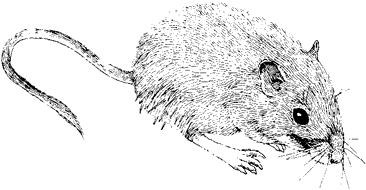
California Pocket Mouse
Distribution, Abundance, and Seasonality
Distributed in California from San Francisco Bay south to the border of Mexico, east to the edge of the Great Valley. Also from Auburn south along the foothills of the Sierra Nevada, and west across the Tehachapi Mts. to the coast. The California pocket mouse inhabits a variety of habitats year-round, including coastal scrub, chamise-redshank and montane chaparral, sagebrush, annual grassland, valley foothill hardwood, valley foothill hardwood-conifer, and montane hardwood habitats. Ranges in elevation from sea level to 2400 m (7900 ft).

Range Map
Specific Habitat Requirements
Feeding: The California pocket mouse feeds mainly on the seeds of annual grasses and forbs, and probably consumes leafy vegetation and insects seasonally. It forages mainly on the ground, but apparently also climbs up into shrubs.
Cover: Occurs in brushy areas but probably is attracted to grass-chaparral edge. Grazing of grassland by domestic stock eliminates cover necessary for predator avoidance.
Reproduction: Young born in burrows dug in soft soil.
Water: Obtained from moisture in seeds and leafy vegetation, and metabolically from foods.
Pattern: The California pocket mouse occurs in chaparral and in grassland, but probably reaches its greatest abundance where these 2 habitats occur in close proximity.
Species Life History
Activity Patterns: Nocturnal. As with other pocket mice, shows reduced activity above ground during winter cold spells (Tinkle and Harmon 1970). Tucker (1966) induced torpor in laboratory animals by limiting food supply. Tucker (1962) noted that torpor could be ended by dropping temperature below 15ÁC (59ÁF).
Seasonal Movements / Migration: None.
Home Range: No data found.
Territory: Aggressively solitary. Territory probably equals home range.
Reproduction: Usually 4 young are born (range 2-7) between April and July (Eisenberg and Isaac 1963). Gestation period is 3-4 wk.
Niche: Predators include coyotes, bobcats, owls, and snakes. As a small-bodied granivore, the California pocket mouse probably competes with Dipodomys heermanni and Peromyscus spp.
Sources & References
California Department of Fish and Game, 1999.
California's Wildlife, Sacramento, CA.
Written by: P. Brylski, reviewed by: H. Shellhammer, edited by: R. Duke
Eisenberg, J. F., and D. E. Isaac. 1963. The reproduction of heteromyid rodents in captivity. J. Mammal. 44:61-67. Tinkle, D. W., and W. Harmon. 1970. Seasonal surface activity in Perognathus longimembris. Amer. Midl. Nat. 84:257-259. Tucker, V. A. 1962. Diurnal torpidity in the California pocket mouse. Science 136:380-381. Tucker, V. A. 1966. Diurnal torpor and its relation to food consumption and weight changes in the California pocket mouse, Perognathus californicus. Ecology 47:245-252.
California Animal Facts | California's Wildlife